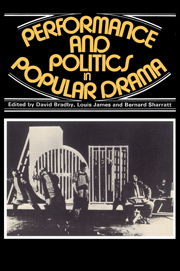 Performance and Politics in Popular Drama
Performance and Politics in Popular Drama Book contents
- Frontmatter
- Contents
- List of contributors
- Preface
- Acknowledgements
- PART ONE Spectacle, performance and audience in nineteenth-century theatre
- PART TWO Politics and performance in twentieth-century drama and film
- Introduction
- Meyerhold and Eisenstein
- Erwin Piscator's 1927 production of Hoppla, We're Alive
- Prolet Buehne: agit-prop in America
- Workers' theatre 1926–36
- The October Group and theatre under the Front Populaire
- Only the stars survive: disaster movies in the seventies
- PART THREE Problems and prospects
- Appendix: Tempo, Tempo
- Select bibliography
- General index
- Index of titles of plays, films, sketches
- Index of theatres, theatre companies and groups
Meyerhold and Eisenstein
Published online by Cambridge University Press: 08 March 2010
- Frontmatter
- Contents
- List of contributors
- Preface
- Acknowledgements
- PART ONE Spectacle, performance and audience in nineteenth-century theatre
- PART TWO Politics and performance in twentieth-century drama and film
- Introduction
- Meyerhold and Eisenstein
- Erwin Piscator's 1927 production of Hoppla, We're Alive
- Prolet Buehne: agit-prop in America
- Workers' theatre 1926–36
- The October Group and theatre under the Front Populaire
- Only the stars survive: disaster movies in the seventies
- PART THREE Problems and prospects
- Appendix: Tempo, Tempo
- Select bibliography
- General index
- Index of titles of plays, films, sketches
- Index of theatres, theatre companies and groups
Summary
When the Bolsheviks seized power in October 1917, few major Russian artists committed themselves unhesitatingly to their cause. Outstanding among those who did were Meyerhold and Eisenstein. In 1917 they were unknown to each other personally although Eisenstein, the younger by nearly twenty-five years, had changed his choice of career from engineering to the arts partly under the influence of Meyerhold's production of Lermontov's Masqueradey which he had seen in Petrograd before the revolution. Eisenstein's work as a designer for Red Army travelling agit-theatre groups at the front during the civil war can be seen as a further consequence of this change of direction. After designing and directing productions at the Proletkult Theatre in 1920, he became a student at Meyerhold's Directors' Workshop in Moscow and, between 1921 and 1922, attended rehearsals and performances of Nora (Meyerhold's version of Ibsen's A Doll's House), Crommelynck's The Magnificent Cuckold and Sukhovo-Kobylin's Tarelkin's Death, acting as personal assistant to the director in the case of the last-mentioned production.
Meyerhold's personal influence on Eisenstein was profound as was, although more indirectly, his artistic influence. By 1924 Eisenstein had abandoned both Meyerhold and the theatre for the ‘higher’ form of the cinema just as, in 1902, Meyerhold had abandoned his own teacher, Stanislavsky, and the latter's naturalist theatre for the ‘higher’ theatre of non-representational form. However, both men retained a life-long feeling of veneration for their respective ‘masters’ and, in a posthumously published essay, Eisenstein expressed an admiration amounting to hero-worship for his own teacher.
- Type
- Chapter
- Information
- Performance and Politics in Popular DramaAspects of Popular Entertainment in Theatre, Film and Television, 1800–1976, pp. 173 - 188Publisher: Cambridge University PressPrint publication year: 1980


